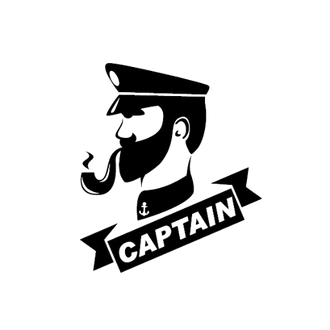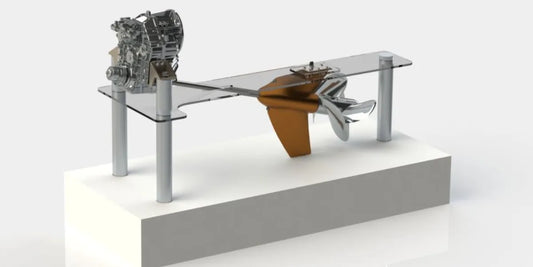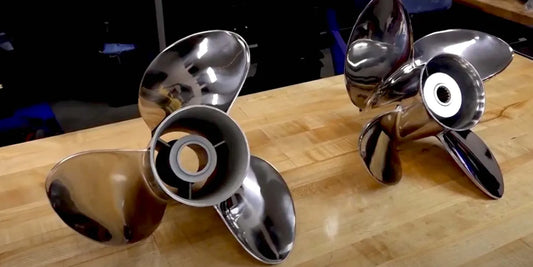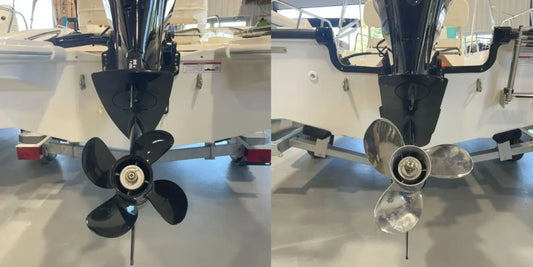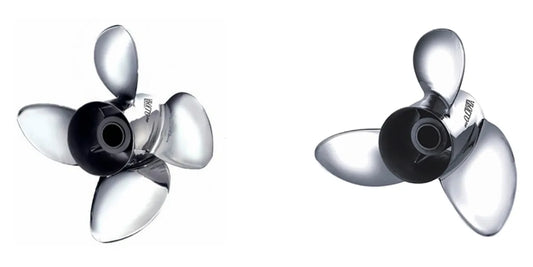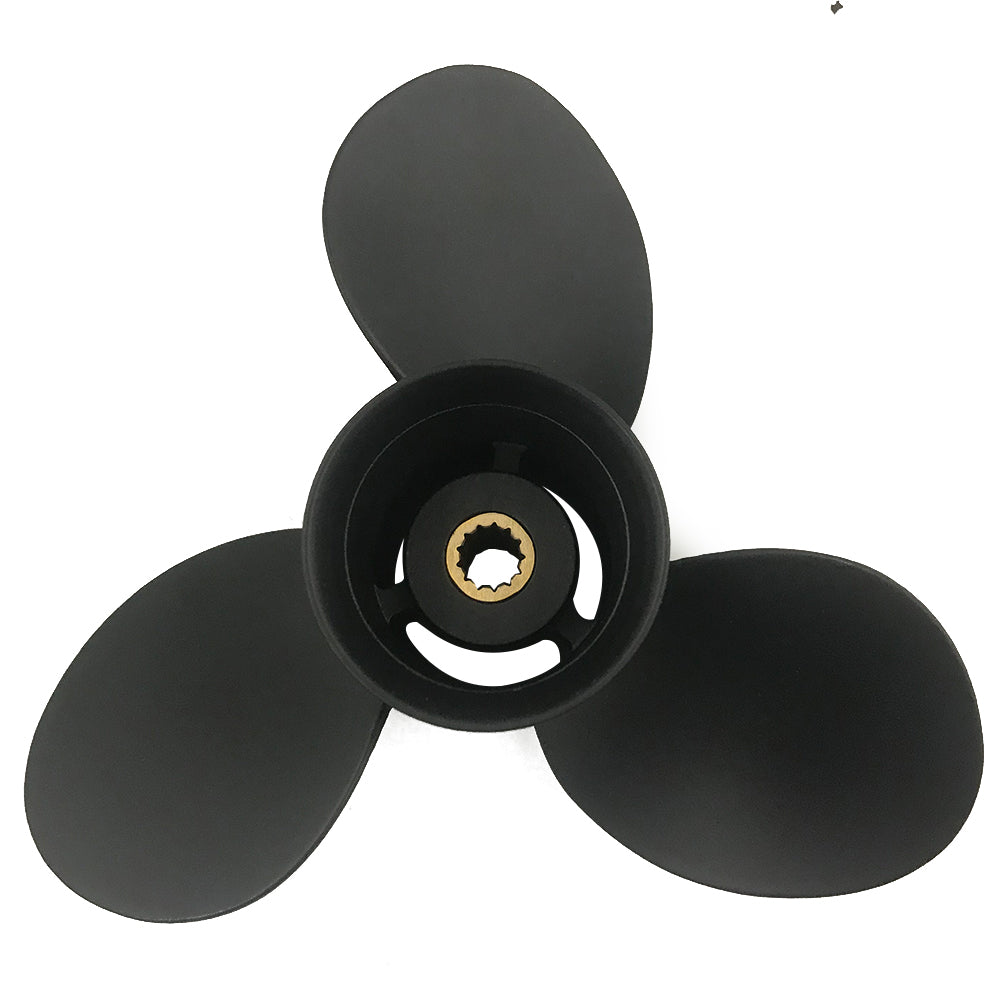Tugboats are the nervous system of maritime operations, driving the sideways and backward movement of giant vessels with pinpoint accuracy and immense power. The tugboat's capability lies in the propleller, which directly influences its efficiency, control, and performance. This guide explores the pivotal role of tugboat propeller technology in modern shipping and harbor operations, explaining the types, designs, and innovations that power these working giants.
Understanding Tugboat Propellers

What is a Tugboat Propeller?
An aqueous thrust would be created by a twisting blade with which water is thrown away from the vessel. Therefore, tugboat propellers have to work at high thrust and low speed, whereas conventional ship propellers are designed mainly for the forward motion of the ship over great distances. Such propellers would have to withstand the very high torque from the engine and also permit sudden changes of direction and thrust by the operator.
Types of Tugboat Propellers
Inoperative operational requirements for tugboats have imposed several special requirements on propeller types. Each is a compromise between power, efficiency, and controllability.
Fixed Pitch Propellers (FPP): These are the more traditional types. The blades are fixed at one angle (pitch). They are simple and challenging, and therefore good for most purposes under certain speed and load conditions. To get thrust variation, an operator has to vary the engine's revolutions, which is often not the most efficient or responsive method.
Controllable Pitch Propeller (CPP): The pitch of the blades in a CPP is hydraulically adjusted. This ensures the engine runs at a constant, optimal RPM, while thrust is controlled by varying the blade angle. Hence, it offers greater versatility in use and enhanced fuel efficiency across load variations, with great maneuverability, including the ability to reverse thrust without reversing shaft rotation.
Ducted Propeller (Kort-Nozzle): The propeller is encased in a non-rotating, hydrodynamically-shaped nozzle or duct. The nozzle speeds up water flow into the propeller, thus providing a large amount of thrust at low speed-a common working condition for tugboats. Thus, some protection is offered to the propeller blades from damage.
Azimuthing Thrusters (Z-drives): This latest system provides the rotation of propeller pods up to 360 degrees about a vertical axis. In such a way, their thrust may be oriented in any direction on a horizontal plane, thus endowing tugboats with extraordinary maneuvering capabilities. Many modern harbor tugs are fitted with Z-drive units that allow them to sidestep, turn, or apply force at precise locations.
Voith-Schneider: An Uncommon Design
The Voith-Schneider Propeller is particularly prominent in propeller technology. Unlike traditional blades, the VSP has vertical, hydrofoil-shaped blades that rotate about a central axis. Each blade's angle changes cyclically during rotation so that the thrust's magnitude and direction can be altered almost instantaneously without changing the engine's rotation speed or direction. This leads to infinite maneuverability, making VSPs best suited for very specialized use where ship-assist tugs or offshore vessels need to be positioned with very precise precision.
The Importance of Propeller Design in Tugboats

Pitch and it Impact on Performance
Pitch is a term in propeller theory, describing the distance which the propeller would theoretically have moved forward in one revolution through a solid medium.
Low Pitch: An underestimated pitch allows the engine to reach maximum RPM quickly and to develop high thrust at low speed. It pulls heavy weight into motion from a standstill.
High Pitch: Thus designed to operate at a high speed, each rotation moves more water. As such, the pull exerted at static condition is hard for an engine to come up with in terms of power requirement.
Tugboat propellers are usually low-pitched to maximize thrust while towing and maneuvering.
Machine Pitch Vs. Fixed Pitch Propellers
There is often confusion between these terms; let us, therefore, distinguish them for clarity. "Fixed Pitch" refers to a propeller whose blades may not be altered throughout operation. "Machining Pitch" is a manufacturing term referring to the angle set during the actual machining or production. The decision between a fixed pitch propeller and a controllable pitch propeller (CPP) is one of the major design factors of tugboats.
FPPs are less complex to operate and maintain than CPPs. Thus, they are a good choice for tugs having a fixed operating profile.
CPPs give the best efficiency through a range of different operating conditions. They offer better steady-state maneuverability and have the fastest response times. They cost more upfront with greater complexity, yet fuel savings over time, and flexibility in operational profile mean they can be a good investment when Tug performance is a significant concern.
Specifications of Modern Tugboat Propellers
Modern tugboat propellers are really marvelous things and are defined by specific attributes:
Diameter: From 2 to 5 meters diameter is chosen to match the engine power and hull design.
Number of Blades: Most tug propellers have 4 or 5 blades. This strikes a balance between efficiency and reduced vibration while delivering maximum thrust.
Material: Nickel-aluminum bronze is commonly used because of its strength and durability thereof, and it is resistant against corrosion and cavitation (damage due to vapor bubble formations).
Bollard Pull: This is an important performance index for a tug, referring to the static pulling force that the tug can exert. Maximizing the bollard pull is, therefore, the main focus of the propeller's design. A typical harbor tug might exert somewhere between 60 and 90 metric tons of bollard pull.
Tugboats as Workhorses in Harbor Operations

The Role of Tugs in Vessel Handling
Container ships, oil tankers, and cruise ships managing high momentum carry very little maneuverability at low speeds. In the making, tugboats are like external engines and rudders that impart thrust in the desired direction to steer those giants.
Docking and Undocking: Tugs push and pull large ships into and out of their berths, carefully so that the ship does not collide with the pier or other vessels.
Escorting: Large vessels may be escorted by tugs through narrow channels or in heavy weather, ready to give immediate assistance should the vessel lose power or steering.
Emergency Response: When the vessel loses engine power, tugs become the primary line of defense against the vessel running aground or drifting into danger.
Efficiency and Power: The Tugboat Workhorse
Being a workhorse is quite an apt term. A harbor tug's engine may run for thousands of hours in a year, often at full load. Efficiency of the tug's propeller system translates directly into fuel consumption and operational costs. Modern propulsion systems, such as Z-drives and CPPs, allow the tug to do the job more quickly and efficiently while saving window fuel, hence contributing to some extent toward sustainable harbor operations.
Advancements in Tugboat Propeller Technology

Innovations in Propeller Materials
Until recently, the nickel-aluminum bronze was generally selected, but very intensive research into new materials is still on-going. For example, composites may provide for lighter blades with more complex geometries, improving hydrodynamic efficiency. New alloys are also under development that will further increase the strength and resistance to cavitation and corrosion so as to increase the service life of propellers.
The Future of Tugboat Propeller Design
In recent years, the development of propeller designs has been greatly shaped by CFD and advanced manufacturing techniques.
Computational Fluid Dynamics: With supercomputers, it has become possible to simulate the complex flow of water around a propeller with great precision. This enables the engineer to evaluate and modify a few hundred designs in a virtual environment to arrive at an optimum shape for a particular application. Even minor improvements to efficiency, but significant enough to advance design considerations, have been obtained through such evaluation and modification.
3D Printing (Additive Manufacturing): This technology is now starting to be applied to the development of propeller prototypes and, in some cases, smaller propellers that can be considered finished goods. It can develop complexities that are difficult or impossible to create by a traditional casting method.
Impact on Fuel Efficiency and Emissions
The environmental impact of a tugboat is related to how efficient the propcaller is. An efficient propeller needs less engine power to generate the same thrust, from which comes the lower fuel consumption. Less fuel burned means less emissions of greenhouse gases (like CO2) and other pollutants (like NOx and SOx). Any innovation that can yield even a few percentage points increase in efficiency translates into tremendous fuel savings and emission reductions over the ship's lifetime.
Choosing the Right Tugboat Propeller

Factors Involved in Propeller Selection
It is a complex matter of weighing many factors:
Tugboat Mission: Is the tug mainly used for harbor assist, long-distance towing, or escort? Each mission will have different requirements of thrust, speed, and maneuverability.
Engine Power and RPM: The propeller has to be matched with the engine characteristics to ensure efficient working without overloading the engine.
Hull Design: Description of the hull also influences the water flowing into the propeller. However, the propeller has to be so designed as to work efficiently with the particular hull form.
Budget: Money is always a factor. Simpler installation such as FPPs may be cheaper to purchase; but fuel savings over the life of a CPP or Z-drive system may very well justify the higher capital outlay.
Maintenance: More complex systems like CPPs and Z-drives require more specialized maintenance. The availability of skilled technicians and spare parts is an important consideration.
Michigan Wheel, Top Manufacturer
Companies like Michigan Wheel have been making propellers for over a century. They manufacture virtually any type of propeller for many marine applications, including custom-made propellers for tugboats. The expertise of the company interlocks metallurgy, hydrodynamics, and manufacture so that each propeller may meet exact specifications for optimum performance and durability.
Customizing Propellers for a Particular Tugboat Model
There is no standardized solution for tugboat propellers. The propeller performs best when custom-designed for a specific vessel. That would involve:
Analyzing the Vessel's Operational Profile.
Using CFD to Model Water Flow around the Hull.
Designing a Propeller Geometry that Would Maximize Thrust and Efficiency for the Particular Application.
Choosing Suitable Materials and Manufacturing Process.
This custom application is for equipping the tugboat to perform its duties as effectively and efficiently as possible.
Reference Sources
-
Tugboat Technology - IEEE USA
Discusses Z-drive propellers and their 360-degree rotation capability, enhancing tugboat maneuverability. -
Propeller Design and Verification Studies for 30–35 Meter Tugboats - ScienceDirect
Explores how tugboat propellers provide high thrust, improve towing efficiency, and reduce fuel consumption. -
Tug Propeller Design | Marine Technology and SNAME
Details methods for designing tugboat propellers using KT-KQ coefficients for various operational conditions. -
Tug Propeller Design and Functionality - Facebook Group
Highlights the advantages of simple construction, low maintenance, and increased efficiency in tugboat propeller designs. -
Voith Schneider Propellers on a Ferry - Reddit
Features insights into innovative propeller designs, such as the Voith-Schneider, used for specialized marine applications.
Frequently Asked Questions (FAQs)
How is a tugboat propeller distinguished and how does it function?
Being the so-called workhorse of the marine industry, the tugboat propeller is engineered to meet the requirements peculiar to tugs. These propellers can be either 3-blade or 4-blade; they are designed for high maneuverability in working conditions, especially in tight waters. The propeller provides efficient power transmission, so even the larger propellers operate effectively under heavy load. Making it requires high-grade alloys to provide durability and abrasion resistance. Such an efficient system is essentially needed for dynamic positioning in towage.
What are the advantages of a 4-blade propeller on a tugboat?
The thrust and efficiency advantages of a 4-bladed engine propelling a tugboat are significant. The increase in blade area allows the propellers, as designed, to generate more lift, which comes in very handy when towing larger ships. Moreover, it increases tugs' maneuverability, enabling them to navigate easily through tight ports. The constant-pitch design effectively transmits power at all speeds, making their applications favorable for the heavy work tugboats perform.
How do designed propellers impart greater performance to tugboats?
Tugboats feature propellers designed to meet the needs of towing and maneuvering larger vessels. These propellers frequently have advanced designs, such as the Kort nozzle or Voith-Schneider drive, to provide greater thrust and control. Thus, by adding blades, one enhances efficiency, more so in a scenario requiring the tug to be responsive to maneuvering. Essentially, the propellers with unique specifications are typically capable of handling high horsepower, making them ideal for heavy towing.
What significance does pitch hold in tugboat propeller design?
An essential element affecting overall performance is the pitch of tugboat-type propellers. Constant pitch means the thrust remains constant across the operating speed range, a necessary feature for towing large ships. Thus, designers will optimize the pitch so that the propeller is efficient over a range of speeds, providing adequate maneuverability for the tug boat, especially under challenging conditions in the case of a tugboat equipped with an appropriately designed pitch, redundant fuel consumption is prevented while still providing power.
Larger propellers for tugboats--how do they affect the performance?
Generally, bigger propellers can be far superior for tugboats because they offer increased thrust and handling capability. Bigger propellers with a larger blade area can transmit power from the engine efficiently, making them ideal for heavy-duty work. Yet the design and underwater dynamics need to be accounted for, as a prop that is too large can also lead to drag. This balance between prop size and efficiency is crucial to keep the tugboat an efficient workhorse capable of maneuvering well.
What materials are used to manufacture tugboat propellers?
The propellers of tugboats are generally manufactured with high-strength alloys to resist abrasion and corrosion. This makes the prop virtually indestructible, even in harsh underwater conditions. Precision engineering is applied to produce not only efficient but also durable props. Modern materials enhance and strengthen the prop, enabling it to withstand towing operations. Quality materials obviously are watchwords on which reliability and performance are based.
